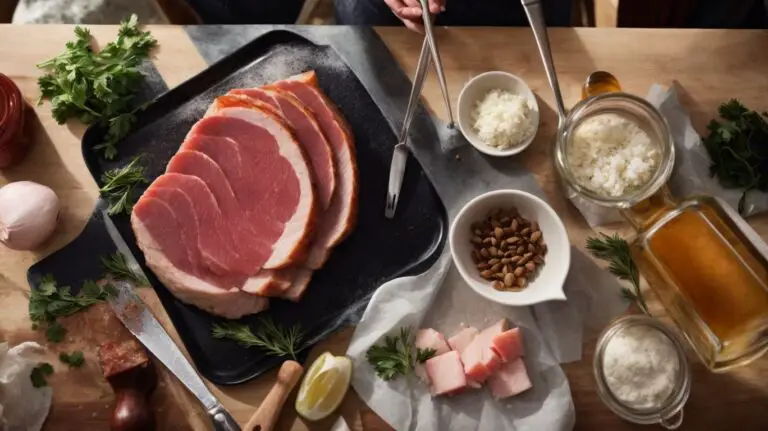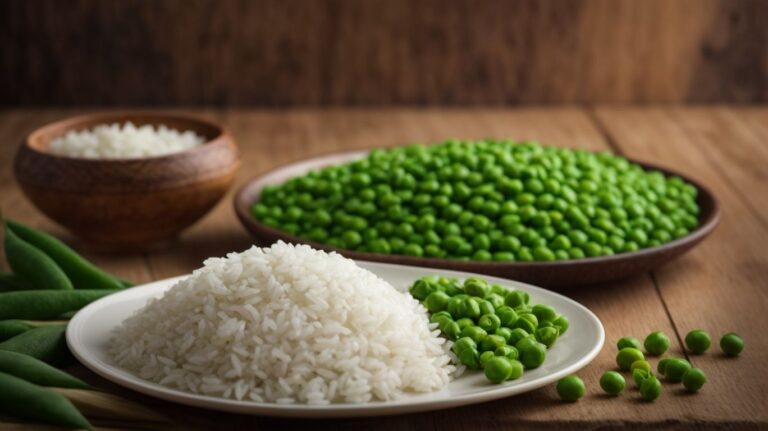How to Cook Pizza From Dough?
Do you ever wonder what makes the perfect pizza dough?
In this article, we will explore the world of dough – from its basic ingredients to different types, and how to make pizza dough from scratch.
We will also share the best tips for achieving that delicious, crispy crust.
Stay tuned to learn how to roll out and shape pizza dough, as well as how to cook a mouth-watering pizza from dough.
Get ready to elevate your pizza-making skills with our expert advice!
Key Takeaways:
What is Dough?
Dough is a versatile mixture of ingredients used in cooking and baking to create a variety of dishes.
Whether it’s a homemade pizza crust, a flaky pie crust, or a batch of soft dinner rolls, dough plays a crucial role in culinary practices across the globe. From kneading the perfect dough to shaping it into loaves or rolling it out on a sheet pan – the possibilities are endless. Dough can be made using various ingredients, with flour being a fundamental component in most recipes. It can also be conveniently purchased as store bought dough, providing convenience for busy cooks or those new to baking.
What Are the Ingredients for Making Dough?
The ingredients for making dough usually include flour, water, yeast, and salt, with variations depending on the type of dough being prepared.
Flour serves as the base of most dough recipes, providing structure and texture. Water activates the gluten in the flour, helping the dough rise and giving it elasticity. Yeast is essential for fermentation, allowing the dough to proof and develop flavor. Salt not only enhances the flavor but also regulates the yeast’s activity and strengthens the dough structure.
Depending on the type of dough, additional ingredients like sugar, oil, eggs, or milk may be added to achieve specific textures or flavors. For example, in homemade pizza dough recipes, olive oil is often included to add richness and enhance the crust’s crispiness.
What Are the Different Types of Dough?
There are various types of dough, including homemade dough, store-bought dough, and specialty dough used for specific baking purposes.
Homemade dough is typically favored by many bakers for its freshness and ability to be customized with preferred ingredients. It offers a personal touch to baked goods, allowing for experimentation with flavors and textures. On the other hand, store-bought dough provides convenience and time-saving benefits, making it a popular choice for those with busy lifestyles or limited baking experience.
How to Make Pizza Dough from Scratch?
Making pizza dough from scratch is a rewarding process that involves a simple recipe and key ingredients like flour, yeast, and olive oil.
If you’re ready to embark on this delicious journey, start by mixing the flour, yeast, salt, and water in a bowl until a shaggy dough forms.
Once combined, turn the dough onto a floured surface and begin kneading it until it becomes smooth and elastic. This step is crucial for developing the gluten in the dough, which gives your crust its structure and texture.
After kneading, place the dough in a lightly oiled bowl, cover it with a clean kitchen towel, and let it rise in a warm spot until it doubles in size, usually around 1-2 hours. This resting period allows the yeast to work its magic and create those airy pockets in your homemade crust.
Step 1: Prepare the Ingredients
The first step in making pizza dough is to gather the necessary ingredients such as flour, water, yeast, and olive oil.
Once you have all your ingredients ready, it’s crucial to ensure their quality as the taste and texture of your homemade pizza greatly depend on it. Using high-quality flour and fresh yeast can make a significant difference in the final result.
When measuring the ingredients, accuracy is key to achieving the perfect consistency. Make sure to level off the flour when measuring to avoid adding too much, which can make the dough dense. Using a digital scale for precise measurements can further enhance the outcome.
Step 2: Mix the Ingredients
Once the ingredients are gathered, the next step is to mix them together in a bowl, forming the initial dough mixture.
As you begin mixing the ingredients, you want to achieve a unified consistency throughout the dough. The crust is a crucial element of a delicious pizza, so the dough should be smooth and elastic, not too sticky or too dry. An ideal texture is soft yet slightly tacky to the touch.
Adding just the right amount of water and kneading the dough thoroughly are key factors in achieving the desired crust quality. Keep in mind that the toppings and cheese will complement the dough, so ensuring a perfect dough texture is essential for the overall pizza experience.
Step 3: Knead the Dough
Kneading the dough is a crucial step in the pizza-making process, as it helps develop gluten and create a smooth, elastic texture.
When kneading dough, you are essentially working the dough to align the gluten proteins properly, which helps create a strong network that traps gas bubbles during the baking process. This trapped gas is what gives pizza its characteristic airy and chewy texture.
To achieve the perfect consistency, aim to knead the dough until it is smooth, elastic, and springs back when poked. Consistency is key; too little kneading will result in a dense, tough crust, while overkneading can lead to a tough and chewy outcome.
Step 4: Let the Dough Rest
Allowing the dough to rest after kneading is essential to activate the yeast and facilitate proper rising, leading to a light and airy crust.
When making pizza, whether using a store-bought crust or crafting your own, the resting period plays a crucial role in enhancing the flavor profile and texture. This phase allows the yeast to reactivate and multiply, leading to the release of carbon dioxide gas, which creates the desired airy structure in the dough. By using a sheet pan for the resting process, you ensure the dough is evenly spread out, promoting consistent rising. The time spent resting also allows the dough to relax, making it easier to shape and stretch without springing back excessively.
Step 5: Shape the Dough
After the dough has rested, it is time to shape it into the desired pizza crust size and thickness, ready for toppings and baking.
When shaping the pizza dough, it’s important to gently work from the center outwards, using your fingers to press the dough into a circular shape. Avoid using a rolling pin at first, as this can deflate the dough and tamper with the texture.
Once you’ve pressed the dough into a rough circle, you can start using a rolling pin. Remember, the key is to apply even pressure as you roll, aiming for a consistent thickness throughout the crust. This will ensure that your pizza bakes evenly in the oven.
For a crispy crust, consider rolling the dough out slightly thinner, while a thicker crust will result in a chewier texture. Experiment with different thicknesses to find your perfect balance of crispiness and chew.
What Are the Best Tips for Making Perfect Pizza Dough?

Credits: Poormet.Com – Frank Jones
Achieving perfect pizza dough involves using high-quality ingredients, precise measurements, and the right techniques to ensure a crispy and delicious crust.
Start by selecting the best flour, preferably a high-protein bread flour, for a chewier texture. Combine this with fresh yeast, warm water, a pinch of sugar, and salt to activate the dough. Knead it until smooth and elastic.
Let the dough rise in a warm spot until it doubles in size. This step is crucial for the dough’s airy texture. When rolling out the dough, ensure it’s an even thickness, providing a consistent base for your favorite toppings.
Tip 1: Use High-Quality Ingredients
One of the key tips for making perfect pizza dough is to use fresh and high-quality ingredients, as they significantly impact the flavor and texture of the final product.
Regarding pizza, the cheese, sauce, and toppings are equally crucial elements that can elevate your pizza game. Starting with premium cheese not only adds richness but also ensures a gooey, satisfying melt that enhances every bite. The sauce serves as the flavorful base, so opting for a quality marinara or homemade sauce can amplify the overall taste profile. Fresh vegetables, meats, and herbs as toppings not only bring vibrant colors but also add layers of taste and texture.
Tip 2: Measure Ingredients Accurately
Accurate measurement of ingredients is crucial in pizza dough preparation to ensure consistency and the desired texture of the crust.
When making pizza dough, even small variations in ingredient quantities can lead to dramatic differences in the final product. For instance, using too much flour can result in a dense and dry crust, while not enough water can lead to a tough and chewy texture.
To achieve the perfect balance, it’s essential to measure each ingredient precisely using the appropriate tools. A digital kitchen scale is highly recommended for accuracy, especially when dealing with flour, yeast, salt, and even Parmesan cheese for added flavor.
Remember, the ingredient ratios play a critical role in determining the overall taste and texture of your pizza. Experimenting with different ratios can help you customize your dough to suit your preferences, whether you prefer a thin and crispy crust or a soft and chewy one.
Tip 3: Use Cold Water
Using cold water when preparing pizza dough helps control the temperature of the mixture and slows down yeast activation, resulting in a more controlled rise and improved flavor development.
By incorporating cold water, you can achieve a dough that develops complex flavors over a longer fermentation period. The slow rise enabled by the cold water allows the yeast to work more gradually, enhancing the overall taste of the dough. Cold water helps in maintaining the dough’s structural integrity, making it easier to handle and shape.
This technique is particularly beneficial for achieving that perfect chewy texture in your pizza crust. To further enhance the dough, olive oil can be added to provide a subtle richness and improve the overall mouthfeel. The end result is a flavorful base that complements the toppings such as mozzarella beautifully.”
Tip 4: Let the Dough Rest for At Least 24 Hours
Allowing the pizza dough to rest for an extended period, ideally 24 hours or more, enhances flavor development, gluten structure, and overall texture for a superior crust.
During this resting time, the yeast fermentable sugars more efficiently, leading to a deeper and more complex flavor profile in the dough. The slow fermentation process also allows for better gluten development, resulting in a stretchier yet more elastic dough that gives that perfect chewy bite when baked. The extended resting period helps in hydrating the flour thoroughly, contributing to a softer and airy texture once the pizza hits the oven. All these factors combined result in a crust with a delicate yet robust balance of flavors and textures.
How to Roll Out and Shape Pizza Dough?
Rolling out and shaping pizza dough requires careful handling and proper technique to achieve an even crust thickness and desired shape for baking.
One essential tip for achieving a crispy crust is to start by using a lightly floured surface and rolling pin to gently flatten the dough. This helps prevent sticking and allows for easier manipulation.
For a sheet pan pizza recipe, make sure to stretch the dough to the edges of the pan evenly to ensure a consistent bake. When shaping different styles like Neapolitan or New York, pay attention to the dough’s elasticity and work it accordingly to achieve the desired thickness.
Experimenting with toppings can also impact how the dough bakes, so consider the weight and moisture content of the ingredients you choose.
How to Cook Pizza from Dough?
Cooking pizza from dough involves preheating the oven, adding toppings to the prepared crust, baking the pizza to perfection, and allowing it to rest before serving for optimal flavor.
Preheating the oven is a crucial first step in achieving a crispy crust and melted cheese. Once the oven reaches the desired temperature, it’s time to assemble the toppings. From classic pepperoni and cheese to gourmet combinations, the choice is yours! Spread the sauce evenly on the crust, followed by your favorite cheeses and toppings.
After carefully crafting your pizza masterpiece, it’s time to bake it. Placing it on a preheated pizza stone or directly on the oven rack can make a difference in the texture. Watch it as it bakes to ensure the cheese melts to gooey goodness without burning the crust.
Once the pizza is perfectly cooked, resist the temptation to dig in right away. Allowing it to rest for a few minutes allows the flavors to meld together, making each bite even more delicious. Now, slice it up, serve, and enjoy your homemade pizza creation!
Step 1: Preheat the Oven
The first step in cooking pizza from dough is to preheat the oven to the recommended temperature, ensuring the crust bakes evenly and achieves the desired texture.
Preheating the oven is a crucial part of the pizza-making process as it sets the stage for a perfect bake. When the oven is properly preheated, it allows the crust to cook evenly, ensuring a crispy and delicious base. For a classic pizza with a crispy crust, it’s recommended to preheat the oven to 450°F to 500°F. This temperature range helps to achieve that perfect balance of a crispy exterior and a soft, chewy interior.
Preheating the oven properly also has an impact on the overall baking outcomes. It helps in achieving that golden-brown color on the crust, which is visually appealing and adds depth of flavor. For those looking to enhance the flavor profile further, a sprinkle of parmesan cheese on the crust before baking can elevate the taste to a whole new level.
Step 2: Add Toppings to the Dough
Once the dough is prepared, adding toppings such as cheese, sauce, and desired ingredients is the next step in creating a flavorful and visually appealing pizza.
Regarding selecting the right toppings for your pizza, it’s crucial to balance flavors and textures. Consider a mix of meats, veggies, and cheeses to create a harmonious taste profile. Toppings like pepperoni, mushrooms, bell peppers, and onions are popular choices that blend well together.
Layering the toppings strategically is key to ensure even distribution and prevent a soggy crust. Start with a base of sauce, followed by cheese to hold everything together. Then, arrange your favorite toppings creatively for an eye-catching presentation.
Experiment with different flavor combinations to elevate your pizza game and surprise your taste buds. From classic margherita to adventurous BBQ chicken, the possibilities are endless. Before placing the pizza in the oven, make sure to preheat it for that perfect crispy crust. Enjoy the process of creating your customized masterpiece!
Step 3: Bake the Pizza
Baking the pizza in a preheated oven ensures that the crust cooks evenly, the cheese melts to perfection, and the toppings are cooked to the right level of tenderness.
For an optimal pizza baking experience, it’s recommended to use a sheet pan to place your homemade or store-bought pizza on. The sheet pan helps distribute heat evenly, resulting in a uniformly baked pizza. Setting the oven at a high temperature, around 475-500°F (245-260°C), is crucial for achieving a crispy crust while keeping the toppings fresh and gooey. Remember to follow the instructions on your pizza packaging.
Step 4: Let the Pizza Rest Before Serving
Allowing the freshly baked pizza to rest for a few minutes before serving enhances the flavors, allows the cheese to set, and prevents toppings from sliding off the crust.
During this resting period, the pizza continues to cook slightly from residual heat, ensuring that all the flavors meld together beautifully. The fresh ingredients reach their optimal taste profile, creating a more cohesive and satisfying eating experience.
For serving, a cooling rack can be useful to keep the bottom crust crisp. Regarding slicing, using a sharp knife or a pizza cutter ensures clean cuts without dragging the toppings. Opt for a triangular or square slice, depending on personal preference and the type of pizza.
Frequently Asked Questions
How to Cook Pizza From Dough?
To cook pizza from dough, you will need to first prepare the dough by kneading it, shaping it into a round crust, and letting it rise. Then, top the dough with your desired toppings and bake it in a preheated oven until the crust is golden brown and the toppings are cooked.
What type of dough is best for making pizza?
The best type of dough for making pizza is one that is high in gluten, such as bread flour or high-gluten flour. This will give the crust a chewy texture and help it to hold its shape when topped and baked.
Can I use store-bought dough to make pizza?
Yes, you can use store-bought dough to make pizza. However, be sure to let the dough come to room temperature before shaping and baking, as cold dough will not stretch and rise properly.
How long should I let the dough rise before baking?
The length of time to let dough rise will depend on the type of dough and the room temperature. Generally, it is recommended to let pizza dough rise for at least an hour to develop flavor and texture. However, some recipes may call for a longer rise time.
What is the best temperature for baking pizza dough?
The best temperature for baking pizza dough is at a high heat, usually around 450-500 degrees Fahrenheit. This will help the crust to cook quickly and evenly, resulting in a crisp and golden crust.
Can I freeze pizza dough for later use?
Yes, pizza dough can be frozen for later use. After shaping the dough, wrap it tightly in plastic wrap and place it in a freezer-safe bag or container. When ready to use, let the dough thaw in the refrigerator overnight before shaping and baking.





